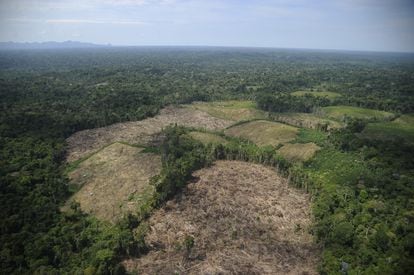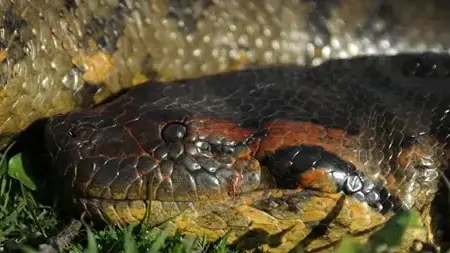Alberto Muñoz carries the 12-kilo chainsaw as if it were a baby, dodging ancient trees with ease while choosing which one to behead.
They are giants that measure more than ten meters and that this woodcutter does not seem to be afraid of.
He tests after a small cut, he lets the wood
bleed
, the sticky sap run before felling.
The machine begins to roar, to cut off, while the team –made up of three people– is positioned strategically so that the trunk does not bury them when it falls.
Some shouts of warning and the final roar.
In 15 minutes they are done.
PHOTO GALLERY
The Peruvian Amazon is consumed
Muñoz lives in the Peruvian town of Masisea, in the Ucayali region, in the Amazon.
Although he is 65 years old, he continues to endure days of extreme temperatures that exceed 12 hours.
The lemon water comforts you while the
mosquitoes
bite incessantly.
Many of his companions contracted dengue fever or malaria, those diseases called “bone-breakers” because of the fever and the muscle contractions they produce.
But Muñoz has been in this business since he was a teenager and knows it well, he does not complain.
“First I used a pure ax in 1978, I had to cut straight.
I earn around 1,000 soles per month –217 euros–.
With the artisanal loggers, every hundred meters you find a tree, but with the big sawmills you go through already exploited areas with nothing, and you have to go farther and farther to get wood.
They are predators.
Likewise, I like what I do;
besides, I'm a carpenter”, he affirms.
His boss, Ramiro Jones, is the one who operates the farm.
"Each log leaves about a hundred euros," he says.
"Corn, plantain, cassava or cocoa do not bring the same money," he adds.
Ornillo, lupuna, catahua, cedar, mahogany, ishpingo, copaiba, lizard, shihuahuaco, cumala, moena, pumaquiro, quillobordon, huairuro, tahuari... These are some of the 85 species of trees that are traded.
The areas of the Sierra del Divisor Park Buffer Zones have been deforested despite the ban.
The aerial panorama is bleakÁngel Sastre
Those of the old school, those who have been in the business for decades, prefer to call themselves artisanal loggers.
Their ancestors dedicated themselves to this trade until the big companies arrived with their bulldozers, destroying everything.
“There is no right, they persecute us when in reality we hardly extract.
Those who destroy are the big companies.
They are making gold,” says Jones.
According to Interpol, Peru loses up to 250 million dollars annually due to large-scale illegal logging.
The day ends.
Muñoz returns to Masisea visibly tired, again with the machinery in tow.
He points to a pink wooden house.
“Don Segundo lives there, he was one of the first to dedicate himself to this, a pioneer.
He became mayor,” he says.
In a wicker chair, staring into space, Segundo Najar waits.
Old family photos and a dusty diploma hang on the walls in recognition of his work.
He is almost 80 years old and is missing a leg that he lost to polio, but he keeps his memory intact.
He claims to belong to another era in which ethical codes were respected;
They are distant times that will no longer return.
"Now things have changed.
To cut down trees, even if they belong to your property or jurisdiction, you need a forestry permit provided by the Ucayali Regional Forestry and Wildlife Management (GERFFS).
For example, an authorization is granted to fell a trunk of nine and a half feet -three meters-, but finally a 13-foot-four meters- one is sold.
In reality, that difference should invalidate the entire process and the employer should be sanctioned.
However, if you pay the official, that's not the case,” he says.
Segundo Najar, from the old guard of loggers, raises his voice in favor of ethical codes when cutting down a forest.
He is almost 80 years old and is missing a leg that he lost to polio, but he keeps his memory intact.Ángel Sastre
“It is legal because the community has permission to use its territory, but at the same time it is informal because what should be deforested is not deforested, but more quantity and larger sizes,” he adds.
The loss of forest cover has become worrying.
According to the report presented by the GRFFS and made through satellite photos provided by the Global Forest Watch and Geoforests platforms, between January and August 2021, 12,345 hectares were deforested.
During the same period of the previous year there were 9,000, which represents a considerable increase.
Helicopter flights by the Peruvian armed forces have also located new unpopulated areas.
Between January and August 2021, 12,345 hectares were deforested.
During the same period of the previous year there were 9,000
Qleofás Quintori, president of the Statutory Congress of the Regional Union of Indigenous Peoples of the Amazon (URPIA), responded strongly to the authorities during the presentation of the aforementioned study.
"I denounce and condemn because they are threatening my leaders," he declared in reference to the farmers, drug traffickers and loggers who intimidate the original peoples.
“For now we are silent, but we prepare.
If at any time something happens, we will rise up with arrows.”
Nearly 21,000 hectares of territory belonging to indigenous communities in the Peruvian Amazon have been deforested for illegal purposes in 2021.
the wooden snake
In a village in Masisea, Washington Lao, a logger, starts the day early.
As soon as the sun rises, he gets up from the hammock, takes out the kilometric antenna and turns on the radio, tuning in to the Ideal station.
Camilo Sexto, Rafael and some tropical cumbia play in the background.
One of the women arrives from the river with two fish: a maiden and a catfish that she cooks by mixing them with rice and bananas, under the fire of a gas cylinder.
Shortly after finishing breakfast, a small excavator bursts in, with big wheels, a lot of power and a battering ram that makes its way through the forest.
They reach the shore, where the gang waits.
The logs sink into the mud.
The team is made up of four people, all Shipibo indigenous, and they all push hard.
After a lot of effort moving pieces that weigh more than 30 kilos, they get the wood to reach the water.
Submerged, Lao props up the logs and joins them with iron to form a floating row that he manages in the boat.
The crossing begins at night to avoid the sun's rays.
When the fog is very thick, Lao has to stop on the shore.
He sometimes gets caught in the fishermen's nets that were left on the road and he must dive to fix the engine.
He uses the tide to spend less gasoline on long stretches.
The moon is his guide, his beacon.
In the morning, after 12 hours, he arrives in Pucallpa, in Ucayali, where he meets one of the sawmills that process the wood.
“We need more documentation and present all the permits because we work by hand,” he says.
Lao buys the trees from Shipibo indigenous people on his land, whom he also contracts to cut and move.
Someone whispers, he complains under his breath: "You pay little for the wood and the work, but the money is money."
A Kakataibo Indian wipes the sweat from his forehead with his T-shirt.
This community, resident in Unipacuyacu, lives waiting for a new attack by illegal loggers.Ángel Sastre
When asking about the data, no one seems to have an idea of the looting committed by the loggers.
The year 2020, marked by the pandemic, was devastating for the Peruvian Amazon.
Deforestation reached 200,000 hectares, a figure that exceeds by 50,000 the amount of forests lost the previous year and the highest in the last two decades, according to the result of satellite monitoring carried out by the Ministry of the Environment (Minam).
blood wood
Anselmo, a member of the Kakataibo people, moves stealthily through the dense jungle.
He wields an old hunting shotgun and a machete.
He has a trained ear and any sound he doesn't recognize alerts him.
He is a warrior within his community, in charge of patrolling and defending his village in Unipacuyacu, between the border between Ucayali and Huánuco.
It is a dangerous area full of smugglers, drug traffickers and loggers.
"Drug traffickers cut down our trees to build clandestine landing strips," he says.
Also coca laboratories, like the one Anselmo finds in the bush.
It is a maceration pool where the leaves float in diluted sulfuric acid.
His community is heavily besieged, cornered.
Cutting down trees means less food, less hunting.
In fact, they have already lost 17,000 hectares of their land.
In addition, since 2016 four local Unipacuyacu leaders who clashed with the settlers have been assassinated.
Their home, the Amazon, has become a lawless territory.
You can follow PLANETA FUTURO on
,
and
, and subscribe
to our 'newsletter'
here
.








